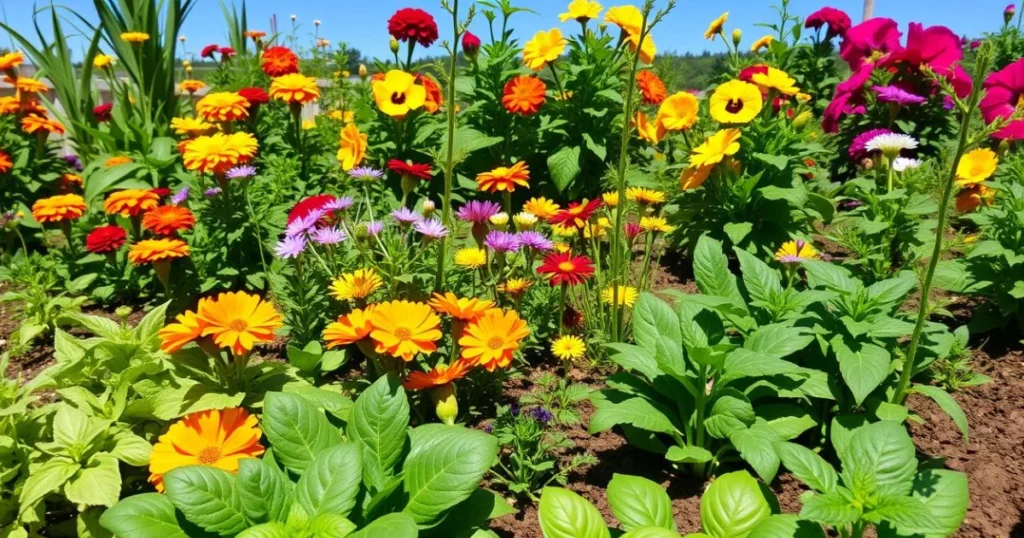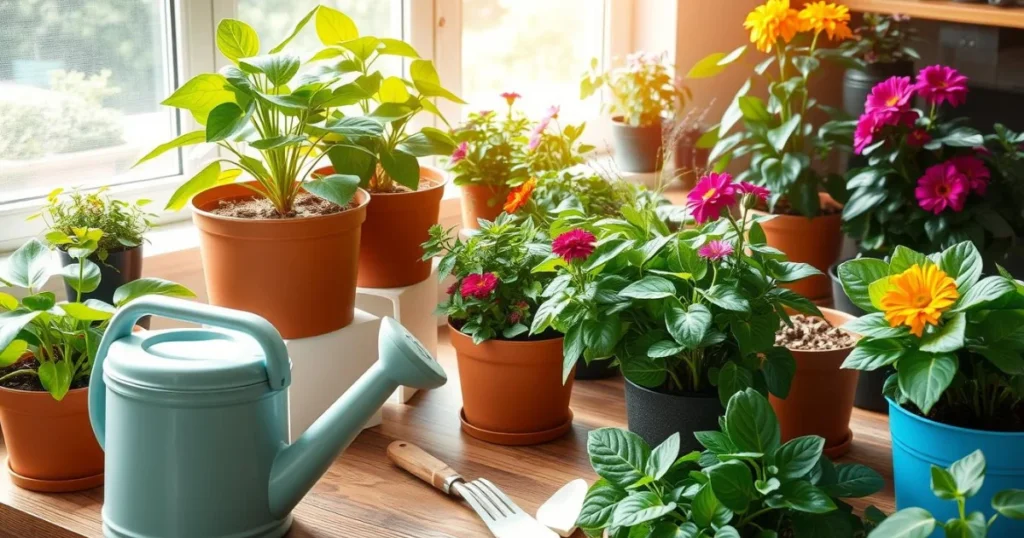Gardening Tips for Beginners: Master Your Garden!
Starting your gardening journey is exciting, especially if you’re new. Whether you’re into indoor or outdoor gardening, knowing the basics is key. Remember, gardening is a learning curve, and mistakes are part of the way.
With the right help, you can create a stunning garden. It’s about choosing the right plants and preparing the soil. Start small and learn the basics of both indoor and outdoor gardening with these Gardening Tips for Beginners. This way, you’ll enjoy the many rewards gardening offers.
Table of Contents
Essential Gardening Tools and Equipment
Gardening needs the right tools and equipment for success. Having the right tools makes gardening fun and rewarding, especially when following Gardening Tips for Beginners. A well-equipped gardener can handle tasks like planting, pruning, watering, and maintenance with ease.
Key tools include a hand pruner, a good watering can, and a soaker hose. A hand pruner is vital for precise pruning. A 2-gallon watering can is best, and a soaker hose saves water by delivering it steadily.
Must-Have Basic Tools
- Long-handled garden tools for easing back strain
- Ergonomically designed scissors and pruners for reducing hand fatigue
- Padded kneelers for comfort and knee pressure reduction
- Soil monitors for determining watering needs and soil pH balance
Optional advanced equipment like a greenhouse or irrigation system can elevate your gardening. Keeping tools and equipment in good condition is key. This guarantees that they function better and endure longer.
Storage and Maintenance Tips
Choose quality materials for tools, like forged metal for shovels and durable rubber for hoses. Regular cleaning and maintenance prevent rust and damage. With the right tools and care, gardening becomes a joy, especially when you follow Gardening Tips for Beginners to ensure long-lasting equipment and a thriving garden.
Understanding Your Garden Space
Creating a thriving garden starts with knowing your space. You need to check the sunlight, temperature, and moisture levels. For outdoor gardens, look at the U.S. Department of Agriculture’s hardiness zones. These zones guide the selection of appropriate plants for your surroundings. Indoor gardens also need careful planning to succeed.
To get the most from your garden, follow these tips:
- Choose plants that fit your hardiness zone for better garden success.
- Find the pH of your soil and its nutrient concentration. Then, adjust it for the best growth.
- Prepare your soil by loosening it 8-12 inches deep. Add organic matter like compost to help.
Whether you have a small balcony or a big backyard, you can create a beautiful garden. Use raised beds to improve soil and protect plants. For indoor gardens, use vertical elements and natural light to your advantage. By understanding your garden space and following these tips, you can enjoy a thriving garden all season long.
Here are some popular garden types:
| Garden Type | Description |
|---|---|
| Outdoor Gardening | Gardening in a yard or outdoor space, using natural sunlight and weather conditions. |
| Indoor Gardening | Gardening in a controlled environment, such as a greenhouse or indoor space, using artificial lighting and climate control. |
Soil Preparation and Testing
Soil preparation is key in gardening. It affects the soil’s fertility and health. Soil testing helps understand the soil’s pH levels and nutrients. A good soil mix is 20% clay, 40% silt, and 40% sand.
Testing your soil’s pH and nutrients every 3 to 5 years is a good idea. The pH range that most plants enjoy is 5.5 to 7. Testing in spring or fall helps prepare for the growing season.
Different Soil Types Explained
Soil types include clay, silt, and sand. Loamy soil, ideal for gardening, has equal parts of these. Knowing your soil type is important for soil preparation and adding amendments.
Soil Amendment Techniques
Soil amendments improve soil structure and fertility. Adding compost, aged manure, or other materials can help. For example, rock phosphate and rock powders can improve soil over time. But, they should be applied every 3 to 4 years.
Choosing the Right Plants for Beginners
Beginners should pick easy-to-grow plants that fit their local climate. Knowing your hardiness zone is key to picking plants that will do well. Succulents, herbs, and vegetables are good choices because they need little care and can handle small mistakes.
Cherry tomatoes, summer squash, and green beans are easy to grow. They need little care and can be ready to eat in 25-30 days. Start with a few plants in a 100 square foot garden (10′ x 10′). This size is perfect for beginners, offering room for many plants and easy upkeep.
Think about how much sunlight your plants need. Full sun plants require six to eight hours of direct sunlight. Partial sun/shade plants need 4-6 hours. Water only once the top two inches of soil are fully dry.Fertilize sparingly to avoid too much. By picking the right plants and caring for them well, beginners can have a thriving garden.

Here are some tips for beginner gardeners:
* Start small and grow your garden gradually
* Pick plants that grow well in your area
* Water and fertilize plants carefully
* Make sure plants get enough sunlight and have good drainage
By following these tips and choosing the right plants, beginners can have a successful and rewarding garden.
| Plant | Sunlight Requirements | Watering Requirements |
|---|---|---|
| Cherry Tomatoes | 6-8 hours of direct sunlight | 1-2 inches of water per week |
| Summer Squash | 6-8 hours of direct sunlight | 1-2 inches of water per week |
| Green Beans | 6-8 hours of direct sunlight | 1-2 inches of water per week |
Fundamental Gardening Tips for Beginners
Starting a garden can be exciting. There are key tips for beginners. These include planting depth guidelines, spacing requirements, and watering schedules. Following these tips can help you grow a beautiful garden.
Planting at the right depth is crucial. The depth varies by plant type. A good rule is to plant seeds 2-3 times deeper than the seed itself. Also, consider the spacing requirements for each plant. Overcrowding can cause disease and pests.
Watering schedules are also vital. Most plants need 1-2 inches of water weekly. This can come from rain or irrigation. By following these tips, you can grow a healthy garden. It will give you fresh produce and beautiful flowers all season.
- Make sure to provide your plants with enough sunlight, as most vegetables need at least 8 hours of direct sunlight per day.
- Use a mix of organic matter and fertilizers to improve soil fertility and structure.
- Keep a garden record to track your progress and identify areas for improvement.
| Gardening Tip | Description |
|---|---|
| Planting Depth | Plant seeds 2-3 times deeper than the seed itself |
| Spacing Requirements | Leave enough space between plants to prevent overcrowding |
| Watering Schedules | Every week, supply one to two inches of water by irrigation or rainfall |
Understanding Plant Care Basics
Proper plant care is key for a healthy garden. It includes regular pruning to promote growth and fight disease. Cutting off dead or sick branches helps plants focus on new growth and flowers.
Plant maintenance also means fertilizing and mulching. Fertilizing gives plants the nutrients they need. Mulching inhibits weed growth and keeps the soil wet. Watering deeply but not often is best for strong roots.
Some important plant care tips are:
- Water when the top inch of ground dries out
- Fertilize when plants are actively growing
- Prune to promote health and prevent disease
- Mulch to keep moisture in and weeds out

By following these tips and keeping up with plant maintenance, your plants will thrive. You’ll enjoy a beautiful and fruitful harvest.
| Plant Type | Watering Needs | Fertilization |
|---|---|---|
| Full Sun Plants | At least 1 inch of water per week | Fertilize during active growing season |
| Partial Shade Plants | Less than 1 inch of water per week | Fertilize during active growing season |
Garden Maintenance Schedule
To keep your garden thriving, it’s key to have a garden maintenance schedule. This schedule should include daily tasks, weekly routines, and seasonal activities. It helps you stay on track and ensures your garden gets the care it needs.
First, list the daily tasks like watering plants, pruning, and fertilizing. These tasks change based on your plants and climate. For example, plants in warm weather need more water, while cooler weather plants need less.
Also, set up weekly routines like mowing the lawn, trimming hedges, and checking for pests or diseases. Don’t forget to include seasonal activities like planting new flowers or vegetables, pruning trees, and applying mulch in your schedule.
Some seasonal activities include:
- Spring: Plant new flowers and vegetables, prune trees and shrubs, and apply mulch
- Summer: Water plants regularly, fertilize, and deadhead spent flowers
- Autumn: Harvest crops, prune trees and shrubs, and prepare the garden for winter
- Winter: Protect plants from frost, prune deciduous trees, and plan for the upcoming gardening season
Following a garden maintenance schedule keeps your garden looking great all year. Never forget to be adaptable and change your calendar as necessary. This way, you can handle changing weather and the unique needs of your plants.
Common Garden Pests and Solutions
Garden pests can harm plants and lower crop yields. It’s key to know the common pests and use natural ways to stop them.
Aphids, whiteflies, spider mites, and slugs are common pests. They damage plants, causing holes in leaves and stunted growth. Natural solutions include introducing beneficial insects like ladybugs, which eat up to 50 aphids a day.
Identifying Harmful Insects
Knowing harmful insects is vital. Caterpillars, thrips, and leafhoppers can harm plants. Put physical barriers like row coverings between them.
Natural Pest Control Methods
Natural pest control is good for the environment. Microbial insecticides can cut pest numbers by 80% without harming good bugs. Companion planting, like marigolds with veggies, can also help by up to 50%.
Preventive Measures
Preventive steps can lower pest risks. Good hygiene and removing debris can cut pest habitats by 60%. Crop rotation can reduce pests by 30% by breaking their life cycles.
Using Integrated Pest Management (IPM) can cut synthetic pesticide use by 50-75%. Encouraging garden biodiversity helps beneficial insects control pests. These steps help gardens stay healthy, reducing the need for natural pest control and garden pests management.
Harvesting and Garden Success
Harvesting your crops is a rewarding experience for gardeners. To achieve garden success, it’s key to follow proper gardening tips. This includes knowing the right time and technique for harvesting.
Some crops are ready in as little as 20 days. Others may take several months. A well-planned garden is essential for garden success.
This means choosing the right crops, preparing the soil, and ensuring enough sunlight and water. By doing these things, you can enjoy a bountiful harvest and celebrate your harvesting success.
When planning your garden, consider a few key factors:
- Select crops compatible for your soil type and climate
- Give each plant enough space to grow
- Use high-quality seeds for better germination
- Keep a record of your planting and harvesting schedule
By following these gardening tips and understanding your crops’ needs, you can achieve
| Crop | Days to Maturity | Harvesting Tips |
|---|---|---|
| Radishes | 20-25 days | Harvest when roots are between 1-2 inches in diameter |
| Tomatoes | 60-90 days | Harvest when fruits are fully ripe and have reached their full color |
| Cucumbers | 50-70 days | Harvest when fruits are between 6-8 inches long and dark green in color |
Troubleshooting Common Garden Problems
Every gardener faces problems at some point. It’s key to know how to spot and fix these issues for a healthy garden. Problems can come from plant disease, growth issues, and weather challenges. Spotting these signs is the first step to solving them.
Overwatering is a common problem. It can cause root rot and wilting, even with wet soil. Yellow leaves often mean too much water, not too little. A soil test can show if your soil lacks nutrients or has the wrong pH.
Plant Disease Recognition
Plant disease is a big problem in gardens. One should be familiar with the indicators of an infection. Fungal infections get worse with poor air and too many plants together. Spacing plants right and using mulch can help prevent these problems.
Growth Issues Solutions
Growth problems come from bad soil, not enough sunlight, and too little water. Knowing what your plants need is key. For example, blueberries need acidic soil, and most veggies like neutral soil.
Weather-Related Challenges
Weather can also hurt your garden, like drought or too much rain. Using drip irrigation and mulch helps. Choosing plants for your USDA zone also helps avoid weather damage.
By knowing common garden problems and how to prevent them, you can have a healthy garden. Keep an eye on your plants and ask for help if you’re not sure. Local gardening clubs and experienced gardeners can offer great advice.
| Common Garden Problems | Causes | Solutions |
|---|---|---|
| Overwatering | Poor drainage, excessive watering | Improve drainage, reduce watering |
| Plant disease | Fungal infections, poor air circulation | Improve air circulation, utilize mulch |
| Growth issues | Poor soil quality, inadequate sunlight | Improve soil quality, provide adequate sunlight |
Conclusion: Growing Your Gardening Journey
Starting your gardening journey is exciting. It’s a journey where you learn every day. Don’t be afraid to face challenges and celebrate your wins. The thrill of seeing your garden grow and enjoying your harvest is just the start.
Use the gardening tips from this article to make your garden come alive. Every garden is different, so be open to trying new things. This will help you find what works best for your garden.
Keep your passion for gardening alive by connecting with others. Join local clubs or online groups. Share your stories, ask for advice, and learn from others. This will keep your gardening journey exciting and rewarding.

